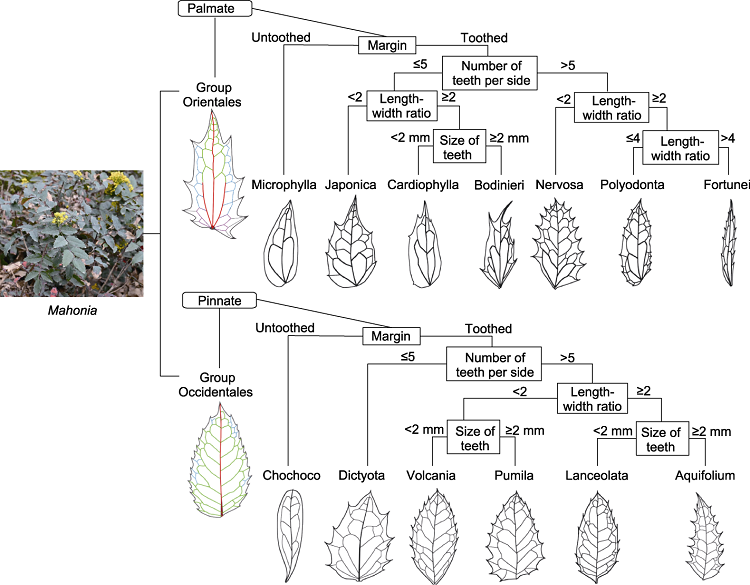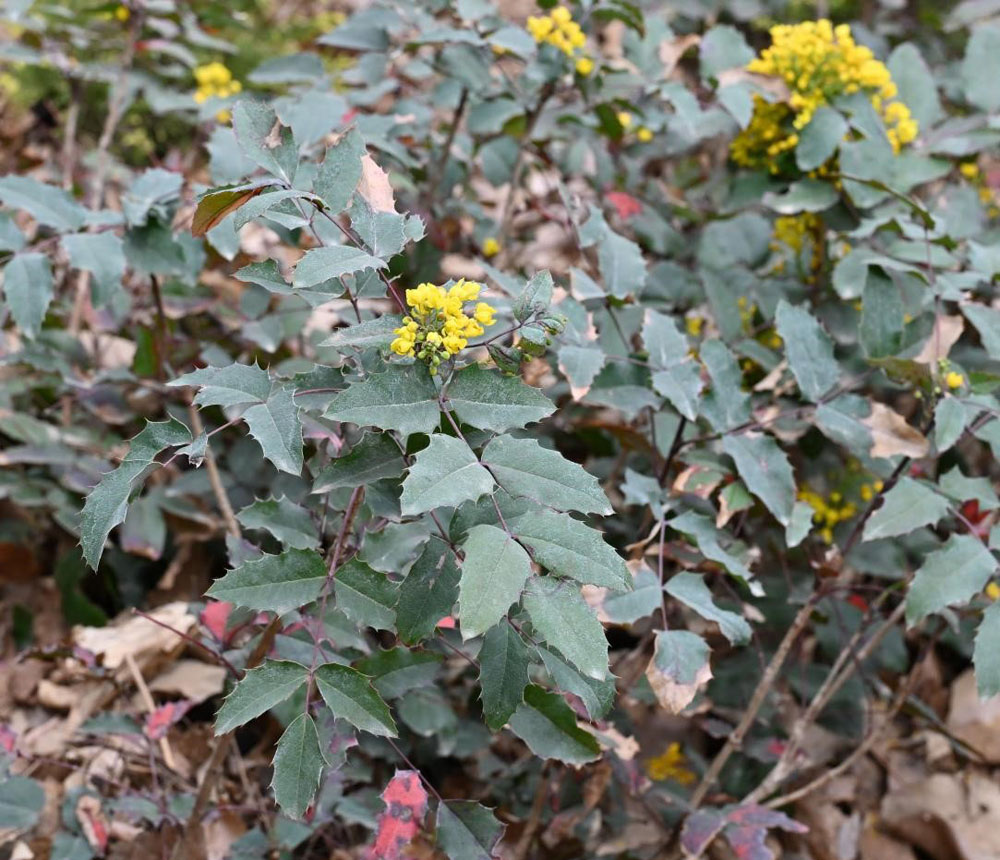

New Leaf Architecture Classification of Mahonia (Berberidaceae)
Received date: 2024-09-27
Accepted date: 2025-01-20
Online published: 2025-01-22
INTRODUCTION Mahonia (Berberidaceae), a basal eudicot lineage, ranks as the second largest genus in the family, comprising approximately 100 species distributed across subtropical to temperate regions of East Asia and North America. The genus exhibits a classic East Asia-Western North America (EA/WNA) disjunction. Notably, Mahonia preserves abundant leaf fossil records in Cenozoic strata of the Northern Hemisphere, reflecting its prolonged evolutionary history. Characterized by distinctive foliar architecture that differs markedly from other angiosperm groups, this genus holds significant potential as a invaluable biological proxy or model plant for investigating the formation of intercontinental disjunct distribution patterns. Its unique morphological traits and biogeographic history provide critical opportunities to trace genus-level morphological evolution and spatio-temporal dynamics against the backdrop of global tectonic movements and climatic shifts.
RATIONALE Through comprehensive morphological surveys of extant Mahonia species, we established a novel leaf architecture classification framework designed for application to fossil leaf typology. This system aims to elucidate the genus’ foliar evolutionary trajectory since the Cenozoic and unravel the historical processes underlying its intercontinental disjunct distribution.
RESULTS Traditionally taxonomist divides Mahonia into two groups based on venation patterns: the palmately veined Group Orientales and the pinnately veined Group Occidentales. Building upon previous studies, we analyzed leaf architecture across 46 extant species and developed a refined subclade classification system using four diagnostic traits: leaflet margin type, serration density (teeth per edge), serration height, and leaflet length-to-width ratio. The Group Oriental was subdivided into seven foliar types (Microphylla, Japonica, Cardiophylla, Bodinieri, Polyodonta, Fortunei, and Nervosa), while the Occidental clade yielded six types (Chochoco, Dictyota, Volcania, Pumila, Lanceolata, and Aquifolium), accompanied by a diagnostic key. Distributional analyses revealed that within Group Orientales, geographic range expands with increasing serration height, whereas in Group Occidentales, distribution range correlates positively with serration density. The framework’s utility was further validated through taxonomic reclassification of two disputed fossil specimens, demonstrating its applicability to paleobotanical studies.
CONCLUSION Our refined foliar classification system for Mahonia represents a significant advancement in precision and granularity over previous systems. This framework holds substantial promise for standardizing Cenozoic leaf fossil typology across the Northern Hemisphere, while providing critical insights into the genus’ foliar evolution and the historical assembly of its intercontinental disjunct distribution pattern.

Retrieval and line drawings of leaf architecture of Mahonia

Bailong Zhao , Yeliang Li , Yufei Wang , Bin Sun . New Leaf Architecture Classification of Mahonia (Berberidaceae)[J]. Chinese Bulletin of Botany, 2025 , 60(4) : 562 -572 . DOI: 10.11983/CBB24149
| [1] | Ahrendt LWA (1961). Berberis and Mahonia: a taxonomic revision. Linn Soc London Proc Bot J 57, 1-410. |
| [2] | Chen XH, Xiang KL, Lian L, Peng HW, Erst AS, Xiang XG, Chen ZD, Wang W (2020). Biogeographic diversification of Mahonia (Berberidaceae): implications for the origin and evolution of East Asian subtropical evergreen broadleaved forests. Mol Phylogenet Evol 151, 106910. |
| [3] | Doweld AB (2018). New names of fossil Berberidaceae. Phytotaxa 351, 72-80. |
| [4] | Feijó A, Ge DY, Wen ZX, Cheng JL, Xia L, Yang QS (2021). Exploring GBIF database and extracting climate data from georeferenced localities with R software. Bio-101 1010609. (in Chinese) |
| Feijó A, 葛德燕, 温知新, 程继龙, 夏霖, 杨奇森 (2021). 利用R软件在GBIF网站下载和筛选物种分布记录并提取气候数据进行分析. Bio-101 1010609. | |
| [5] | Güner TH, Denk T (2012). The genus Mahonia in the Miocene of Turkey: taxonomy and biogeographic implications. Rev Palaeobot Palynol 175, 32-46. |
| [6] | Hsieh CL, Yu CC, Huang YL, Chung KF (2022). Mahonia vs. Berberis unloaded: generic delimitation and infrafamilial classification of Berberidaceae based on plastid phylogenomics. Front Plant Sci 12, 720171. |
| [7] | Hu Q, Huang J, Chen YF, Manchester SR (2017). Mahonia fossils from the Oligocene of South China: taxonomic and biogeographic implications. Palaeoworld 26, 691-698. |
| [8] | Huang J, Su T, Lebereton-Anberrée J, Zhang ST, Zhou ZK (2016). The oldest Mahonia (Berberidaceae) fossil from East Asia and its biogeographic implications. J Plant Res 129, 209-223. |
| [9] | Kayseri MS (2010). Oligo-miocene Palynology, Palaeobotany, Vertebrate, Marine Faunas, Palaeoclimatology and Palaeovegetation of the ?ren Basin (North of the G?kova Gulf), Western Anatolia. PhD dissertation. Izmir: Dokuz Eylül üniversitesi. pp. 1-569. |
| [10] | Kva?ek Z, Teodoridis V (2019). A putative Australian element in the European Miocene re-investigated—Mahonia exulata (UNGER) KVA?EK & TEODORIDIS comb. nov. et emend. N Jb Geol Palaontol Abh 293, 139-143. |
| [11] | Kva?ek Z, Teodoridis V, Roiron P (2011). A forgotten Miocene mastixioid flora of Arjuzanx (Landes, SW France). Palaeontogr Abt B Palaeophytol 285, 3-111. |
| [12] | Mai DH, Walther H (1988). Die plioz?nen floren von thüringen, deutsche demokratische republik. Quart?rpal?ontolo- gie 7, 55-242. |
| [13] | Manchester SR (2000). Late Eocene fossil plants of the John Day Formation, Wheeler County, Oregon. Oreg Geol 62, 51-63, 84. |
| [14] | Manchester SR (2001). Update on the megafossil flora of Florissant, Colorado. Denver Mus Nat Sci 4, 137-161. |
| [15] | Postigo-Mijarra JM, Barrón E, DiéGuez C (2014). The late Miocene macroflora of the La Cerdanya Basin (Eastern Pyrenees, Spain): towards a synthesis. Palaeontogr Abt B Palaeophytol 291, 85-129. |
| [16] | Tang DL, Wang ZE, Ding H, Huang YT, Ding ST, Wu JY (2023). New discovery of Mahonia fossils from the Pliocene of Yunnan, China, and its biogeographical significance. Hist Biol 35, 2435-2448. |
| [17] | The Angiosperm Phylogeny Group (2016). An update of the angiosperm phylogeny group classification for the orders and families of flowering plants: APG IV. Bot J Linn Soc 181, 1-20. |
| [18] | Wu JY (2008). Revision of the Mahonia (Berberidaceae) in China. PhD dissertation. Beijing: Institute of Botany, Chinese Academy of Sciences. pp. 1-105. (in Chinese) |
| 武建勇 (2008). 国产十大功劳属植物的分类学修订. 博士论文. 北京: 中国科学院植物研究所. pp. 1-105. | |
| [19] | Ying J, Boufford D, Brach A (2011). Berberidaceae. Beijing: Science Press. pp. 772-782. |
| [20] | Yu CC, Chung KF (2017). Why Mahonia? Molecular recircumscription of Berberis s.l., with the description of two new genera, Alloberberis and Moranothamnus. Taxon 66, 1371-1392. |
/
| 〈 |
|
〉 |